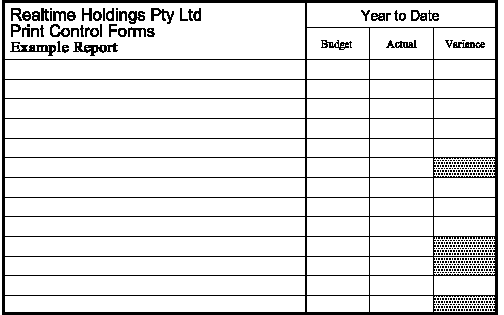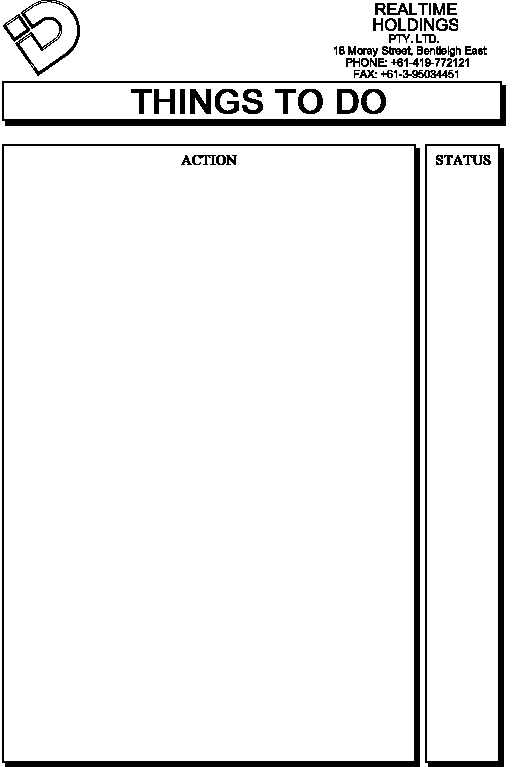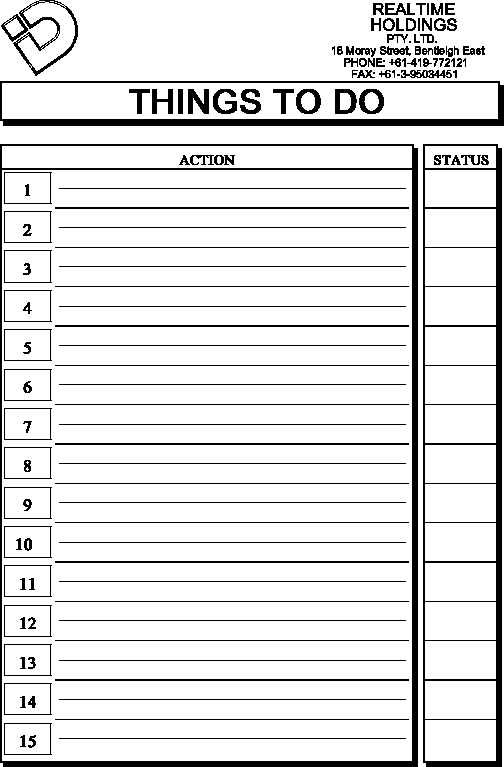Forms source code
Example 1 - Form created with Print Control Forms.
univers = 52;What this example shows
times = 5;
normal = 0;
bold = 3;fill(119.63, 68, 16.33, 5, 15);
fill(119.63, 88, 16.33, 10, 15);
fill(119.63, 103, 16.33, 5, 15);
box(10, 28, 126, 80, 0.7);
vert(87, 28, 80, 0.3);
vert(103.3, 35, 73, 0.1, 2, 16.33);
hor(87, 35, 49, 0.1);
hor(10, 43, 126, 0.1, 13, 5);
font(univers, 12, normal);
text(12, 33, "Realtime Holdings Pty Ltd");
ntext("Print Control Forms");
font(times, 11, bold);
ntext("Example Report");
font(univers, 10, normal);
text(111.5, 33, "c", "Year to Date");
font(times, 8, normal);
text(95.1, 40, "c", "Budget");
text(111.5, 40, "c", "Actual");
text(127.7, 40, "c", "Variance");
In this example you will be shown how to;
Explanationuse the box function to draw a box, use the hor and vert function to draw single and multiple vertical and horizontal lines, use the fill function to shade an area, define a font, use the text command to position text.
| Source code | Explanation |
| univers = 52;
times = 5; normal = 0; bold = 3; |
Define constants which will be used for font selection when the font() function is called. |
| fill(119.63, 68, 16.33,
5, 15);
fill(119.63, 88, 16.33, 10, 15); fill(119.63, 103, 16.33, 5, 15); |
The form contains some areas which will not contain data, these are
to be
shaded. The fill() function is used. The first fill pattern is an area to start 199.63 mm from the left margin and 68 mm from the top margin. The area to be filled is 16.33 mm wide and 5 mm deep. The fill pattern is 15% shade. |
| box(10, 28, 126, 80, 0.7); | Draw a box starting at 10 mm from left margin and 28 mm from the top margin, 126 mm wide and 80 mm deep, 0.7 mm thick. |
| vert(87, 28, 80, 0.3); | Draw one vertical line to divide the Year to Date section from the description section. This line is 87 mm from the left margin, also starts 28 mm from the top margin, it is 80 mm long and 0.3 mm thick. |
| vert(103.3, 35, 73, 0.1, 2, 16.33); | Draw two vertical lines to divide the Year to Date section and create the Budget, Actual and Variance sections. The first line starts 103.3 mm from the left margin and 35 mm from the top margin. The line in 73 mm long and 0.1 mm thick. Two optional parameters are also nominated. These are the number of lines to be drawn, in this case 2, and the distance apart, in this case 16.33 mm. |
| hor(87, 35, 49, 0.1); | Draw one horizontal line above the Year to Date column descriptions. This line starts 87 mm from the left hand margin, and 35 mm from the top margin. The line is 49 mm long and 0.1 mm thick. |
| hor(10, 43, 126, 0.1, 13, 5); | Draw the balance of the horizontal lines. The first line starts at 10 mm from the left hand margin and 43 mm from the top margin, each line is 126 mm long and 0.1 mm thick. Two optional parameters are also nominated. These are the number of lines to be drawn, in this case 13, and the distance apart, in this case 5 mm. |
| This completes the linework. Now to add text to the form. | |
| font(univers, 12, normal); | Nominate the font to be used. The first text is to use a helvetica (univers) typeface, 12 point size and normal weight. |
| text(12, 33, "Realtime Holdings Pty Ltd"); | The text command is used to place the first string of text 12 mm from the left margin and 33 mm from the top margin. As there are no previous text commands ragged right margin alignment will be assumed. |
| ntext("Print Control Forms"); | The next line of text is to be placed starting at the same indent from the left margin and positioned vertically according to the point size being used. The ntext() function is used which indicates that the text is to be located immediately below the previous line using normal line spacing and assuming all of the attributes of the previous text function call. In this case to start 12 mm from the left margin and with ragged right alignment. |
| font(times, 11, bold); | The next line of text is to use Times Roman typeface, 11 point size and bold weight. |
| ntext("Example Report"); | Like the previous ntext() function, the next line of text is to be located relative to the last. A ntext() function is therefore used again. |
| font(univers, 10, normal); | The next line of text is to use a helvetica (univers) typeface, 10 point size and normal weight. |
| text(111.5, 33, "c", "Year to Date"); | The next string of text is to be centred above the three columns on the right hand side of the form. The centre position is calculated to be 111.5 mm from the left hand margin and the text is to start 33 mm from the top margin. A text() function with the format defined as "c" is used. Using the font typeface and size previously nominated the dimensions of each character that makes up the string of text will be used to calculate how to place the text to centre it 111.5 mm from the left margin. |
| font(times, 8, normal); | The column headers will use a helvetica (univers) typeface, 8 point size and normal weight. |
| text(95.1, 40, "c", "Budget"); | The next string of text is to also be centred, this time in the first column of the Year to Date section. Again the text() function is used to centre the text 95.1 mm from the left margin and 40 mm from the top margin. |
| text(111.5, "Actual");
text(127.7, "Variance"); |
The final two strings of text are to also be centred in the next column. |
| Note: it is only necessary to nominate the offset from the left margin in the last two function calls. The other attributes such as centre text and the distance from the top margin are assumed from the previous function call. |
Running the programme
To print this example to a laser printer;
pcf -TPCL < $Utools/Utools/macros/source/pcf_example1 | lp -dlaseror to create a PDF file;
pcf -TPDF < $Utools/Utools/macros/source/pcr_example1 > /tmp/pcf_example1.pdf


